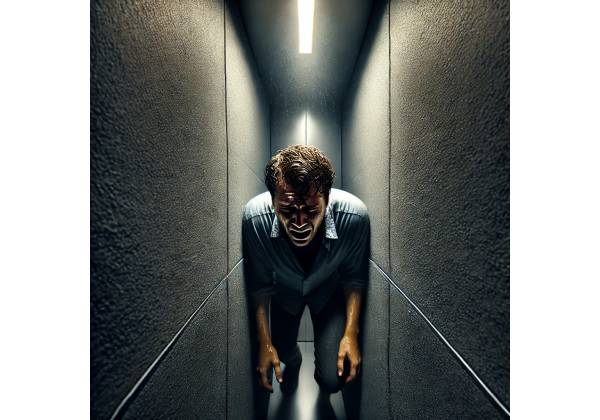What is Claustrophobia?
Claustrophobia is an irrational fear of being in confined or enclosed spaces. Individuals with this phobia experience intense anxiety or panic when they find themselves in places like elevators, small rooms, or crowded areas. This fear can be triggered by the perception of being trapped with no clear way out. Many people experience overwhelming anxiety as a result of claustrophobia, which leads to avoidance behaviors that interfere with their daily lives.
Claustrophobia is a common phobia that affects a large proportion of the population, and its severity can range from mild discomfort to full-fledged panic episodes. The fear is frequently linked to a sense of loss of control, with people fearing they will suffocate or be unable to escape. This phobia can be especially disruptive because many routine activities—such as taking public transportation, entering small offices, or undergoing medical procedures like MRI scans—can cause significant distress.
While claustrophobia is a recognized anxiety disorder, there are effective treatments available to help people manage, and in some cases overcome, their fear. Individuals suffering from claustrophobia can improve their quality of life by learning about the symptoms, causes, and available treatments.
Symptoms of Claustrophobia
The symptoms of claustrophobia vary greatly depending on the individual and the severity of their condition. These symptoms typically appear when a person is in or anticipates being in a confined space, though they can also occur spontaneously. Claustrophobia symptoms are classified into physical, emotional, and behavioral manifestations.
Physical Symptoms
The physical symptoms of claustrophobia are caused by the body’s natural reaction to perceived danger, known as the “fight-or-flight” response. These symptoms may include:
- Rapid heartbeat (tachycardia): When exposed to confined spaces, people with claustrophobia frequently experience an increase in heart rate as their bodies prepare to deal with the perceived threat.
- Shortness of breath: Many people with claustrophobia feel suffocated or struggle to breathe, even in well-ventilated spaces.
- Sweating: Excessive sweating, especially in the hands and face, is a common physical response to claustrophobic situations.
- Chest tightness or pain: Anxiety in confined spaces can cause a sensation of tightness in the chest, which can be misinterpreted as a more serious medical condition such as a heart attack.
- Dizziness or lightheadedness: As a result of their increased anxiety, people may feel faint or lightheaded.
- Nausea: The stress of being in a small, enclosed space may cause nausea or vomiting.
- Trembling or shaking: Another common physical symptom associated with high anxiety is uncontrollable shaking or trembling.
Emotional Symptoms
Claustrophobia has a strong emotional impact, often causing overwhelming fear, panic, or dread in confined spaces. Emotional symptoms could include:
- Panic attacks: In more severe cases, people may experience full-fledged panic attacks, which are marked by intense fear, rapid breathing, and a sense of impending doom. These attacks can happen suddenly and without warning.
- Intense fear of suffocation: A major emotional symptom of claustrophobia is the fear of not being able to breathe, even if the space is well-ventilated. This fear frequently exacerbates the anxiety felt in confined spaces.
- Anticipatory anxiety: Many people with claustrophobia suffer from anticipatory anxiety, which occurs when the mere thought of being in a confined space causes anxiety, even if they are not currently in that situation.
- Feelings of helplessness: When confronted with a confined space, people frequently feel trapped or helpless, which can lead to increased emotional distress.
Behavioral Symptoms
Claustrophobia can also cause specific behavioral changes, especially avoidance behaviors. These behaviors are intended to protect people from confined spaces, but they can have a negative impact on daily functioning. Typical behavioral symptoms include:
- Avoidance of elevators, small rooms, or tunnels: Many people try to avoid confined spaces. For example, they may choose to take the stairs rather than the elevator, even if it results in significant inconvenience.
- Refusal to undergo medical procedures such as MRIs: Because MRIs require individuals to remain in a confined tube-like machine, people with claustrophobia frequently refuse or postpone necessary medical tests out of fear.
- Leaving situations prematurely: People may leave meetings, social gatherings, or transportation situations if they feel confined or trapped.
- Pacing or fidgeting: Some people engage in nervous behaviors, such as pacing or fidgeting, to cope with the anxiety of being in a confined space.
Causes and Risk Factors for Claustrophobia
Claustrophobia can develop from a variety of causes, including genetic, environmental, and psychological influences. Understanding these factors is essential for successfully addressing and treating the phobia.
Traumatic Experiences
One of the most common causes of claustrophobia is a traumatic experience in confined space. For example, being trapped in an elevator, stuck in a crowded room, or involved in an accident where escape was difficult can instill long-term fears. These traumatic experiences frequently produce strong negative associations with confined spaces, resulting in the development of claustrophobia.
Learned Behaviors
Claustrophobia can be a learned behavior. If a child sees a parent or close family member expressing fear or anxiety in confined spaces, they may mimic these behaviors themselves. Similarly, negative reinforcement (e.g., feeling relieved after escaping a confined space) can strengthen the phobia.
Genetic Predisposition
There is evidence to suggest that people with a family history of anxiety disorders or phobias are more likely to develop claustrophobia. This genetic predisposition, when combined with environmental factors, increases the risk of developing the condition.
Brain Function & Conditioning
Claustrophobia may also be associated with specific brain functions. According to research, people who suffer from claustrophobia may have an overactive amygdala, which is responsible for processing fear. When confronted with confined spaces, this increased activity can trigger a more intense fear response.
Additionally, classical conditioning influences the development of claustrophobia. If a person repeatedly experiences anxiety or panic in confined spaces, their brain may learn to associate those spaces with danger, reinforcing the phobia.
Co-occurring Mental Health Conditions
Claustrophobia is frequently linked to other mental health issues, including generalized anxiety disorder (GAD), panic disorder, and post-traumatic stress disorder (PTSD). Individuals with these conditions may be more likely to develop specific phobias, such as claustrophobia.
How Claustrophobia is Diagnosed
A mental health professional must conduct a thorough evaluation before claustrophobia can be diagnosed. The diagnosis is based on the individual’s symptoms, medical history, and how the phobia affects their daily life.
Clinical Interview
The diagnostic process begins with a clinical interview, during which the healthcare provider will inquire about the patient’s symptoms, experiences with confined spaces, and any avoidance behaviors. The goal is to get a complete picture of how claustrophobia affects the person’s life and rule out any other possible causes of anxiety.
Symptom Assessment
To confirm a diagnosis of claustrophobia, the mental health professional will evaluate the severity and duration of the symptoms. The individual must have had significant anxiety about confined spaces for at least six months, and this anxiety must interfere with their ability to function in daily life.
Diagnostic Criteria
Claustrophobia is listed as a specific phobia in the Diagnostic and Statistical Manual of Mental Disorders (DSM-5). To be diagnosed, individuals must meet the following criteria:
- A strong fear or anxiety about confined spaces.
- When exposed to confined spaces, an immediate anxiety response occurs.
- Recognize that your fear is excessive or unreasonable.
- Avoiding confined spaces or enduring them with extreme distress.
- Fear causes significant distress or impairment in social, occupational, or other critical areas of functioning.
Differential Diagnosis
Before making a diagnosis, the clinician will rule out any other conditions that could cause similar symptoms, such as panic disorder, agoraphobia, or social anxiety disorder. A differential diagnosis ensures that the treatment plan is specific to claustrophobia while also addressing any co-occurring conditions.
Treatment Alternatives for Claustrophobia
Claustrophobia is a highly treatable condition, and there are numerous therapeutic options available to help people manage and, in many cases, overcome their fear. Treatment is usually tailored to the individual’s specific requirements and may include a variety of therapies.
Cognitive-Behavioral Therapy (CBT)
Cognitive Behavioral Therapy (CBT) is a highly effective treatment for claustrophobia. CBT assists individuals in identifying and challenging the irrational thoughts and beliefs that fuel their fear of confined spaces.
- Cognitive Restructuring: In this phase of CBT, patients work with a therapist to replace negative thought patterns with more rational and balanced thinking. For example, if a person believes they will suffocate in a small room, cognitive restructuring assists them in challenging this belief and realizing that the room is safe.
- Exposure Therapy: Exposure therapy, an important component of CBT, entails gradually exposing the individual to confined spaces in a controlled setting. Individuals who confront their fear in a safe environment gradually become desensitized to confined spaces.
Virtual Reality Therapy(VRT)
Virtual Reality Therapy (VRT) provides an immersive and safe alternative to traditional exposure therapy. It enables people to confront their fear of confined spaces, such as elevators or crowded rooms, in a safe virtual setting. This method allows patients to gradually develop tolerance for confined spaces without the immediate stress of real-life exposure.
- Simulated Exposure: With VRT, people are exposed to increasingly difficult environments, allowing them to confront their fears gradually. This exposure gradually desensitizes the brain to confined spaces, reducing anxiety in real-life situations.
Mindfulness and Relaxation Techniques
In addition to therapeutic approaches such as CBT and VRT, incorporating mindfulness and relaxation techniques can help people manage the physical symptoms of anxiety caused by claustrophobia. These strategies are intended to calm the body’s response to stress and keep people grounded during times of high anxiety.
- Deep Breathing Exercises: Controlled breathing can help alleviate the immediate physical symptoms of panic, such as a racing heart or shortness of breath.
- Progressive Muscle Relaxation: By focusing on tensing and then relaxing each muscle group, people can relieve physical tension caused by anxiety.
- Mindfulness Meditation: Mindfulness encourages people to stay in the present moment and observe their anxious thoughts without judgment. This practice aids individuals in remaining grounded during episodes of fear and anxiety in confined spaces.
Medications for Anxiety
Individuals with severe claustrophobia may benefit from medication to help manage anxiety symptoms, especially when exposed to confined spaces. Medication is typically prescribed as part of a comprehensive treatment plan that may include therapy.
- Selective Serotonin Reuptake Inhibitors (SSRIs): These antidepressants regulate serotonin levels in the brain, thereby reducing the severity of anxiety. SSRIs are commonly prescribed to people who have chronic or severe claustrophobia.
- Benzodiazepines: In cases of acute anxiety, such as during an MRI scan or air travel, short-term benzodiazepine use may be recommended. These medications provide quick relief from anxiety, but they are not typically recommended for long-term use due to the risk of dependence.
Group Therapy and Support Networks
Group therapy offers a supportive environment in which people with claustrophobia can share their experiences and work on coping strategies with others who face similar challenges. Being part of a group can reduce feelings of isolation and provide emotional support, making people more motivated to face their fears.
- Peer Support: Group therapy sessions foster a sense of community among participants, providing encouragement, practical advice, and mutual understanding throughout the treatment process.
- Skill Development: In group therapy, participants can learn new coping skills and anxiety-management techniques from both the therapist and other members.
Self-Help Strategies
In addition to professional treatment, people suffering from claustrophobia can benefit from self-help strategies for managing symptoms in daily life. These strategies enable people to take proactive steps to reduce their anxiety outside of therapy sessions.
- Gradual Exposure on Your Own: People can begin by gradually exposing themselves to mildly confined spaces before progressing to more anxiety-provoking situations. For example, spend a few minutes in a small room before taking the elevator.
- Mindfulness Apps: Mobile apps that focus on mindfulness and breathing exercises can help people cope with stress and anxiety in confined spaces.
- Journaling: Keeping a journal to document anxious thoughts and track progress can help people identify patterns and track their progress over time.











